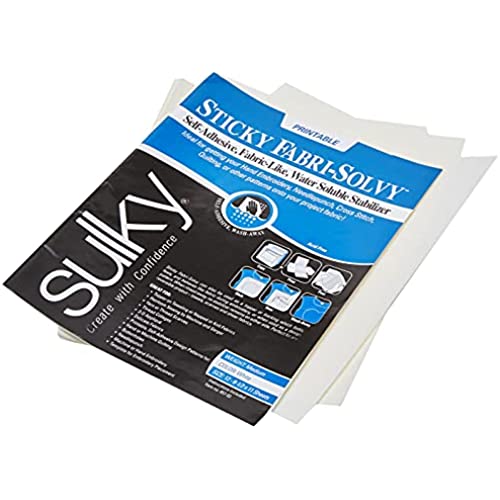
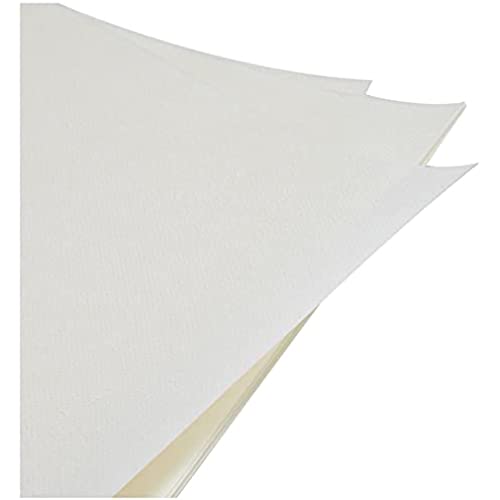
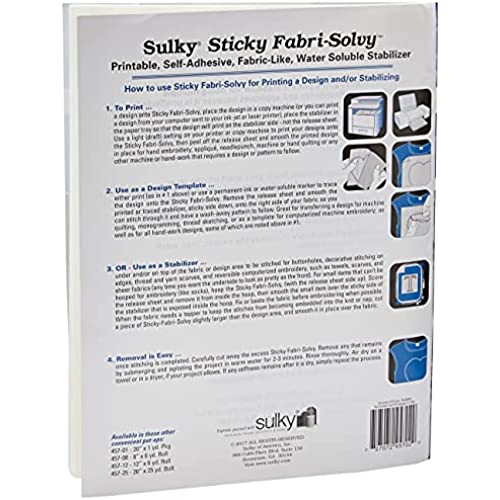
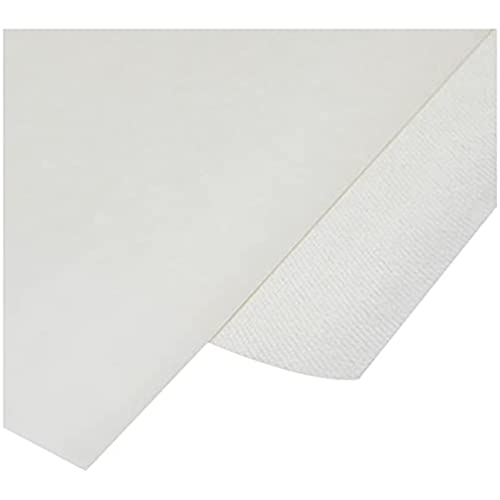
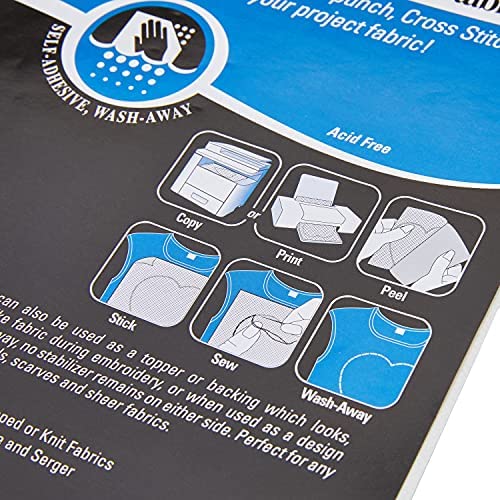
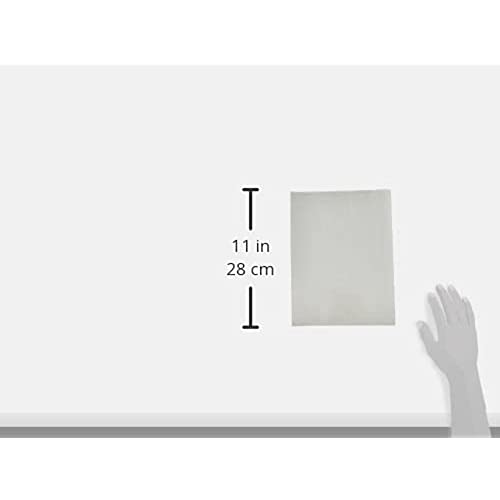






Sulky 8.5x11 stabilizer, 8.5 x 11 12-Pack, White
-

ahb
> 3 dayIm doing an embroidery project that has a lot of detailed lines. For my last project I used my laptop as a light box to trace the pattern onto fabric, but I knew that wasnt going to work for this one--there is just too much detail, and no way to keep the fabric from moving around while I trace. My daughter mentioned shed seen something on Instagram about traceable embroidery fabric, so I came to Amazon and found these. I ordered them, they came the next day, and that afternoon I printed my pattern out, stuck it to my fabric, and voila! Im all set! I can embroider over a perfectly replicated pattern. Also, the Sulky fabric is super flexible, so if, like me, youre going to cover every inch of it with embroidery, you dont even have to worry about removing it later if you dont want to. Im so happy with these!
-

Dayanara
> 3 dayI liked this product for embridery. Since embroidering on clothes. This stabilizer easily held on and stuck until I washed it. It washed off like it was never there to begin with! Highly recommend this stabilizer if you want to print a design to make. I used this to stitch anime characters and anime related things to my clothing (yes I’m a weeb) but with this embroidering designs are endless. Just copy a picture, paste it into google docs or word (whichever you so choose) adjust the size, change it to black and white or keep the color, and stitch away!
-

Celtic Girl
Greater than one weekI love to embroider, but I dont enjoy transferring the pattern to the foundation fabric. I had three embroidery books with designs I was just itching to start stitching from--Simply Stitched by Yumiko Higuchi (an English translation of the Japanese Wool Stitch), available at Amazon, and two of Higuchis other books, Embroidery Life to Enjoy in Two Colors and One Color Embroidery and Goods (in Japanese; neither have been translated into English but both are available at Amazon and have awesome embroidery designs in them). I dont know where I came across this Sulky product (an embroidery blog?), but I decided to give it a try, even though the reviews were mixed. Within a week, I had half a dozen projects embroidered (and one embroidered needle book completed to give as a gift)--all thanks to this Sulky product. Here are some tips to get the best out of the product: Two out of three of the sheets that I sent through my printer went through effortlessly, but the third one jammed. Be sure that the corners of the page are in good shape (not bent or separating) before sending it through the printer. I printed a bunch of small projects (needle books, sachets, etc.) that filled the Sulky fabric sheet, then cut out the design I wanted to work on (I cut in between the sheets sticky side and its printed fabric side), leaving the remaining designs on the page until Im ready to use them (I put a piece of freezer paper over the top of the empty space on the page so it wont stick to anything). Then you just stick the design onto your fabric foundation of choice and start stitching. Though the product info says that a needle goes through the sticky Sulky fabric sheet easily and doesnt leave any residue, while this is mostly true, it does take me a little more oomph to get the needle through the layers sometimes (of course, the type of needle and foundation fabric you use will determine how smoothly it goes through as well). I used a variety of threads and flosses (Aurifil wool thread, overdyed/hand-dyed floss, DMC, Appleton crewel wool, etc.), all on various Robert Kaufman linen blends. The first design I did had quite a few French knots on it, and I was nervous about how the Sulky product would dissolve after stitching was completed, but it worked BEAUTIFULLY (even on the wool!). To finish, I used a shallow bowl with lukewarm water, put the embroidered design in it, swished it around, helped remove the fabric stickiness with my fingers, rinsed it in cold water, and hung it up to dry. There was no color bleeding (though you should use colorfast threads to be sure). Another benefit of this product is that when working on smaller projects, I didnt need to use a hoop, because the Sulky sheet acted as a stabilizer. This saved having to use a fabric piece that was big enough to hoop (which means savings in linen/fabric too). Another HUGE selling point for me is that it will be easy to embroider items like scarves and other clothing and home dec--basically, anywhere you can stitch with a needle and thread, which makes this a very versatile product. Ill use this product all the time now. Im so happy to actually be embroidering again; its very gratifying to see some finished pieces and to be looking forward to doing more. I will happily pay the price of this product to avoid hand-transferring designs.
-

Tash50Tash50
> 3 dayI was very hesitant to use this product, and avoided it for awhile after seeing some of the negative reviews. Im so glad I took the chance as Ive had nothing but great experiences and amazing projects with the use of sulky. I use this for hand embroidery. This product has taken my stitching projects from good to great! This is very simple to use and makes stitching on terry, knit, cotton, waffle threaded and a myriad of other fabrics even, professional looking and beautiful. It not only stabilizes the fabric but allows your stitches to sit on top of the fabric perfectly. The stitches do not sink into the fabric, your stitches dont pull threads of the fabric up with your stitches (as stitching on terry can do without the proper stabilizer). And my favorite part is that this is a stabilizer that also serves as pattern for your stitching. I use it one of two ways. The 1st way I use it is to hand draw with a regular pencil, whatever design or words it is I want to stitch on the sulky sheet. Or, I print what I want to stitch (pictures or specific font for words or a combination of the two) on the sulky sheet. I take whatever hoop Im using (some fabrics you dont need a hoop for if the fabric has some firmness - but I hoop most of them) and then place that on top of the sulky sheet that has the design on it. I use the outside of the hoop to trace, with a pencil, the outside rim of my hoop with my design in the middle as it would be if hooped up. This shows where my hoop, at its outer edges will extend. Then I trim the excess sulky sheet around that line, adding an additional two or so inches as the sulky should extend beyond the hoop after you have hooped your project. I prepare my fabric, peel off the back side of the sheet and it sticks to the fabric. I hoop the fabric which now has the sulky stuck to the front, and begin to sew! It is very easy and another benefit, if youre like me, is that the sulky has small little dots evenly spaced on the sheet. Not printed dots, but small little dots, almost like tiny depressions thats part of the sheet makeup. I use those to help ensure my stitches are even and spaced. Thats just a byproduct I didnt expect. It helps me keep all my stitches exactly the same size. If you dont need them, it wont hurt your project any as I didnt even realize they were there until my 2nd use of the sheets. After Im done with my stitching, I un-hoop it and pull up the edges of those excess inches of sulky that had extended around my hoop. I then trim off as much of the excess sulky as possible. I then take a bowl of very hot tap water and place the project in it. I agitate, or stir, lightly for 1-2 minutes and that dissolves whatever sulky is left on the fabric. If it doesnt come all off in the first minute or two, dump your water and start with fresh water and repeat. Ive only had to do that once, but I think it was because I didnt trim as much of the excess off as I should have. After I have dissolved the sulky in the bowl of hot water. I rinse my fabric it under the faucet with warm water to ensure I have all of the dissolved agent off of my fabric. And Im not gentle with it (Im not beating it on a rock or washing board either, but you neednt be overly ginger). After I have rinsed it thoroughly and squeezed excess water out, I let it air dry. After that, I usually either hand wash it or wash it on a gentle cycle after before giving it as a gift or incorporating it into another project Im working on. Thats it! It really is very simple. There are wonderful instructions included. Now, there have been some comments left on other reviews with experiences I have never had or my fellow stitching sisters who I shared this wonderful find with. The only side effect Ive had is that you need to keep your needle sharp. They do tend to dull a bit quicker when using the sulky sheet. I think this is understandable as you are going through two layers instead of one and the sulky feels a little thick when you 1st start using it. Ive never had a gummed up needle and Ive done over 40 projects with this. What I do is have my needle emery handy, or the purple needle sharpener pad is what I prefer to use, and when I change thread colors, or if the needle feels a little dull - I just sharpen it up. Problem solved. The end product is a beautifully stitched product where your stitches threads/design is on top of your fabric evenly as opposed to swallowed by it or, if using knit or cotton fabrics which stretch, it keeps your fabric stable while simultaneously having your pattern as a map directly on the stabilizing agent. Then when your done stitching, that stabilizer isnt visible on the back. It really is great and I suggest it whole heartedly. Stitchers enjoy this great tool for our sewing box! Id be happy to respond to any questions if left in the comment section. I was really nervous the first time I used it so I did a small project, a sampler, in order to test it. Im happy to say it passed with flying cotton flouche and over dyed colors! One last warning - you might just become sulky addicted. I did.
-

Kindle Customer
> 3 daySo easy to use. I can draw or print. It sticks to the fabric well and rinses off easily.
-

mz johansen
> 3 dayIf half stars were allowed this would be 4.5. All in all I am a big fan of this product. It works so well for copying embroidery, or other, kinds of patterns. It adheres to your fabric and is very easy to sew through. It washes away completely, soak to,lift and then I use a bit more pressure or a soft brush to get to the smaller and more heavily stitched areas. Simple. Easy. Effective. The only reason I would consider subtracting a half star is because ,as you sew, embroider or manipulate the fabric the edges can lift slightly. That being said, the slight lifting has never affected the sewing areas and it is very minimal....so this is really just a niggle, not a real problem. For the convenience and multiuse use-ability of this product I cannot think of anything that produces a better result! Love it!
-

Ria
> 3 dayThe Sulky Printable Fabric Solvy stabilizer, 8.5 x 11 12-Pack, White is a very good product. I use this product for hand embroidery. Its not very tacky and is very easy to dissolve in water.
-

Liana
> 3 dayI haven’t tried to remove it yet, so that could get interesting. So far, I’m very pleased with how easy it was to print directly on to the material and how well it has stuck to the canvas of my project. I can see so many fun projects in the future with this product!
-

Edwin C.
> 3 dayFue mejor de lo que esperaba, es un buen producto y mis bordados no se vieron afectados por el adhesivo
-

Corrie
> 3 dayEver since I was given a sheet of this stuff years ago I have been in love; every year for the past 15 years I have hand embroidered a design on the breast pocket of a jacket for my father. I used to rely on simple designs or I would just wing it and hope my spacing and design would work out. Transfer pencils and the so called disappearing markers never worked for me, either the weave of the jacket would be too loose/soft or the jacket would have both light and dark colors like the plaids that my dad prefers (yes, if you were wondering he is a stereotypical lumberjack). I can now simply print out even complex embroidery designs for materials that are both dark and light without struggling to see the markings like last years stag beetle, a fighting marlin, or the company logo for his business. With even basic skills in photo editing software like Photoshop or Gimp you can easily turn any image into an embroidery design. Using these sheets has taken my embroidery work from something that was obviously homemade (like the awful stick figure cutting down a tree that I did 12 years ago) to something that people think was custom made at a high end professional embroidery shop (maybe the extra decade of experience has a little bit to do with that as well heheheheh). The material can easily be used in a home printer, sticks well to both tightly woven and more porous material, and dissolves easily in even tepid water. Just be sure to make sure which side of the paper your printer will print on before loading the sheets in and hitting print.

